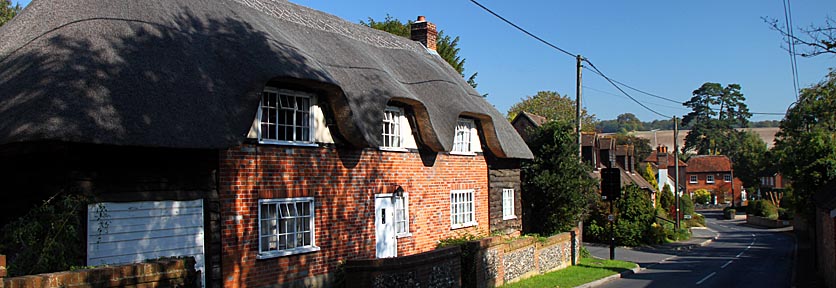 |
 |
|||
|
|
Hampstead Norreys Centre of Norman Goldsmithing
Bronze age man lived, or certainly died, in this area. There is a barrow from that time on the slopes below Beech (or Beche) wood, just east of the village. Originally there were two. When excavated, it revealed the body of a man with a dagger. In Park Wood, just south-west of the church are some minor earthworks which some think are the remains of an unfinished Iron Age hillfort. Much more prominent is Oareborough Castle, which stands half in Hampstead Norreys, though it lies near Bradley in eastern Chieveley. The Romans worked the land around Eling, the small hamlet just south of the village, but the villa they lived in was just over the parish boundary in Yattendon. There are also a few earthworks, now almost untraceable, around Hampstead Norreys Church which, it has been suggested, are the temenos of a Roman temple which the Saxons replaced with the church. However, it is not near a Roman Road and it is down in the Valley of the River Pang rather than the usual hilltop location. When the Saxons did arrive and founded Hampstead, this was certainly the area they chose to settle in. The name means what it sounds like – a ‘homestead’. At the time of the Domesday Survey of 1086, Hampstead was owned by Theodoric the Goldsmith. This German immigrant was the finest gold and silver craftsman in London, if not the Country, in late Saxon times. His chief country estate was at Kennington in Surrey but, after the Norman Conquest, William the Conqueror gave him a number of other manors in order to keep him in the Country and working for the Crown. Five of these were in Berkshire where there was good woodland for smelting metal, and they appear to have been centred on Hampstead Norreys. Behind the church, in Westbrook Copse, can be seen the motte of a small Norman castle which Theodoric may have built to protect his precious stores of metal and jewels. By the late 12th century, the manor was in the hands of the Sifrewast family from Clewer and the village became Hampstead Sifrewast. In 1276, it was purchased by Sir Robert de Muscegros, a Somerset knight who may have been in need of a residence nearer London. Later, the manor passed to the family of his son-in-law, John, Baron Ferrers of Chartley in Staffordshire. The village then became known as Hampstead Ferrers. On the south wall of the parish church is displayed a rather high quality 13th century stone carving of a jousting knight. There is some confusion as to what it once decorated, but the general opinion seems to be that it was part of a coffin lid-type ledger stone over an important grave. Could it have lain over the grave of Robert de Muscegros or one of the other manor lords? The de Ferrers are unlikely to have visited Hampstead and probably had a steward run the estate. In 1448, Sir John Norreys, from adjoining Yattendon, purchased the manor. His family lived at Yattendon Castle and Ockwells Manor in Bray. In the 1540s, while his grandson, John, was living at Yattendon, it is possible that the latter’s nephew, Henry, later Lord Norreys of Rycote, moved into Hampstead Manor for a short time. The central hall range of the house is certainly of 16th century date and there is a staircase of a similar period. The rest is 18th and 19th century. There are four other manors in the parish, from west to east: Langley, Bothampstead, Eling and Wyld Court. The demolished Langley Hall, at the first, was the home of the prolific West Berkshire family of Head from about 1650. Walter James Head was created a baronet in 1791, but changed his surname to James and moved to Denford Park. The dramatic career of his eldest son, Francis, is recorded on his monument in the parish church. He was Assistant Adjutant General under the Duke of Wellington and was killed in 1812 at the age of only twenty-four during the attack on Badajos in Portugal. Wyld Court, the last named manor, is the site of a deserted medieval village and now the home of the 'Rain Forest Experience'. At its core, the present house is 18th century. See also other places in the ancient parish: Hermitage.
|
|||
| © Nash Ford Publishing 2011. All Rights Reserved. | ||||



